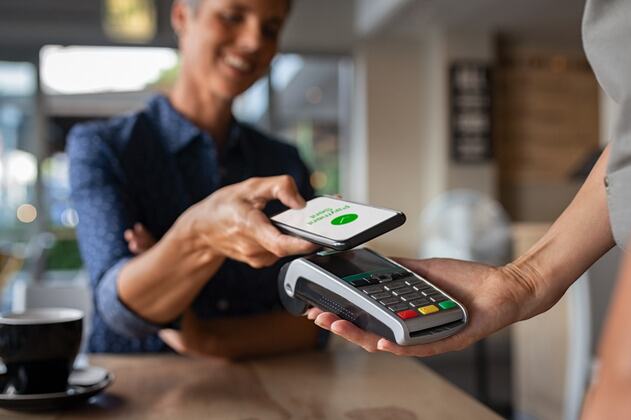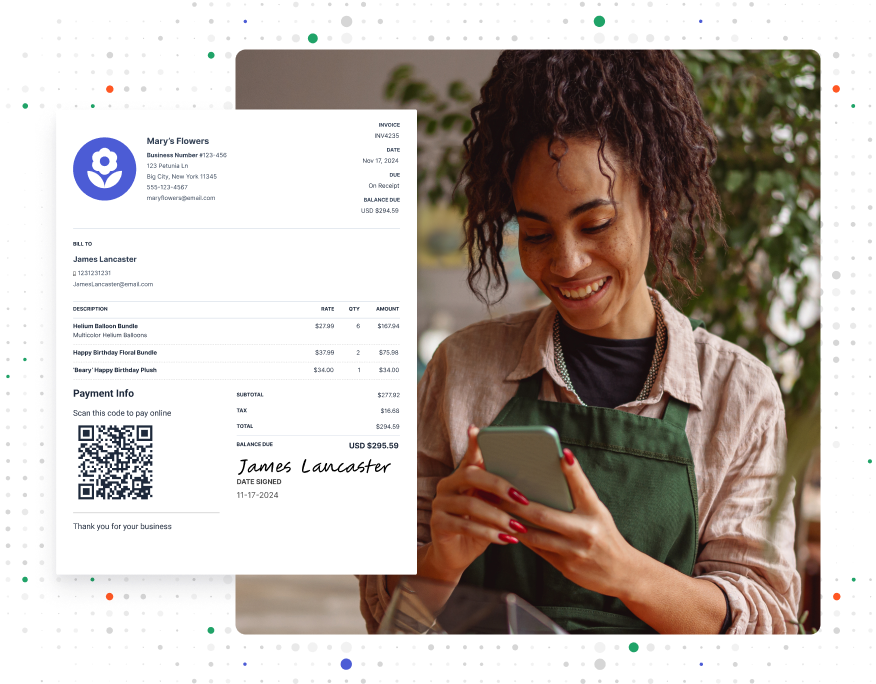The Most Popular Mobile Payment Methods for Business Owners

The days of digging through your wallet for cash or the right credit card are numbered. That’s because the simplicity and security of mobile payments are changing the way people pay. In fact, 53% of people now use digital wallets more often than other payment methods, according to a survey from Forbes Advisor.
Mobile payments are transactions made using a portable electronic device, usually a smartphone. This technology lets people pay digitally instead of with cash, checks, or physical cards. And as a business, implementing mobile payments saves both you and your customers time.
Here’s a guide to the different types of mobile payment methods and apps, along with tips for choosing the best one for your business.
What Is a Mobile Payment?
Mobile payments are transactions facilitated by a portable electronic device, such as a smartphone, smartwatch, or tablet. This includes buying goods, paying for services, or even sending money to friends and family.
Payment apps securely connect to the user’s bank account, credit card, or debit card. When a customer is ready to buy something or send money, they can do it directly through the app with a few taps on their device. This means they don’t need to carry around a wallet full of cash or cards.
Convenience is a huge advantage of this system. People can pay anytime, anywhere. Whether you’re splitting a restaurant bill with friends, buying a coffee on the way to work, or shopping online, mobile payments make transactions quick and easy. And as a business owner, you don’t have to take many steps to set it up.
RELATED ARTICLE — How To Accept Credit Card Payments On Your Phone / Tablet
7 Benefits of Mobile Payment Methods

Mobile payment methods offer a host of advantages over cash, cards, and other traditional payment methods. Here are the key benefits:
1. Convenience
With mobile payments, customers can complete transactions on the go using their phones or devices. This ease of use can lead to higher customer satisfaction and loyalty.
2. Speed
Mobile payments are often faster than traditional payment methods. Customers can check out quickly without counting out cash or swiping a card. This efficiency shortens the checkout process and enhances the overall shopping experience.
3. Security
Mobile payment apps use advanced technology to safeguard sensitive financial information. Credit and debit card data is never actually stored on the device. This reduces the chance of fraud and data breaches.
4. Privacy
Customers’ personal information stays private. People don’t have to share their credit card details with the merchant or anyone else. This limits the risk of identity theft or unauthorized charges.
5. Budgeting
Some apps include, or integrate with, budgeting tools and expense-tracking features. These can help customers manage their spending and stick to their financial goals.
6. Reduced Costs for Merchants
Mobile payment apps usually have lower transaction fees than credit card companies. That means you save money when customers use them. Plus, the streamlined checkout process can cut labor costs and boost your operational efficiency.
7. Contactless Payments
Mobile payments offer a sanitary alternative to cards and cash. People don’t have to touch a point-of-sale machine or worry about handling money.
FROM ONE OF OUR PARTNERS — Why Your Small Business Should Accept Mobile Payments
5 Types of Mobile Payment Apps
Mobile payment methods all share one thing in common: Customers use them to send payments from their devices. But there are many different ways that money gets from the customer to a business’s bank account. Here are some of the most common:
1. Mobile Wallets
A mobile wallet is an app that stores credit card, debit card, or bank account information securely on a smartphone. This lets customers make purchases without physically carrying their debit and credit cards. So, how does mobile payment work? It employs one of two systems:
Near Field Communication (NFC) Payments
NFC is a technology that enables contactless payments. A customer simply holds their phone near a compatible payment terminal to complete a transaction. It works the same as tapping a card.
QR Code Payments
A QR code is a barcode that can be read by a digital device, like a smartphone camera. Customers scan a merchant’s QR code with a wallet app and confirm the payment.
2. Mobile Banking Apps
Most traditional banks now offer mobile apps that let customers manage their finances on the go. Among other features, these apps let people:
- Transfer money between accounts
- Pay bills
- Deposit checks by taking a photo
- View their transaction history
These apps don’t usually work for in-person, contactless purchases. Think of them more as an additional tool to a mobile wallet or peer-to-peer (P2P) payment app.
3. SMS Payments
SMS payments are often used for charitable donations. In this case, the donator texts a specific code to a designated number to contribute a preset amount. The charge then appears on their phone bill. While SMS payments are less common, they’re helpful for businesses asking for preset, one-time payments.
4. Direct Carrier Billing
With this convenient type of billing, customers can make purchases and have the charges added directly to their phone bill. This is common for digital goods like apps, games, and streaming services.
5. P2P Payments
P2P payment apps let you send money directly to friends or family using their email addresses or phone numbers. These apps are often free for users and are a convenient way to split expenses or send money as a gift. They’re also helpful for small businesses because they’re easy to set up. Venmo, Cash App, and Zelle are all common options.
FROM ONE OF OUR PARTNERS — How Does Mobile Payment Processing Work?
5 Most Popular Examples of Mobile Payment Methods

Here’s a breakdown of some of the best mobile payment apps out there. All are available to merchants and customers anywhere in North America, except for Zelle, which is U.S.-only.
Remember: You don’t have to choose just one payment service. Platforms like Stripe and Square offer integrations with multiple mobile apps. This means you can offer customers more payment options without having to manage multiple accounts or systems.
1. PayPal
PayPal is a big name for a reason. It’s easy for customers and merchants alike to use. To make a purchase, someone does need to have an account, but it’s easy and free to sign up with email. Plus, PayPal has anti-fraud protections for both sides of each transaction.
Pros
- Widely known and accepted
- Easy to set up and use
- Supports many payment methods and use cases
Cons
- Fees are on the higher side
- Fee structure can be confusing
Good For
- Online businesses that need an app that works well with their shopping platform
Fees
- No monthly fees for the basic account
- $5–$30 for upgraded accounts
- In-person payments are 2.29% + $0.09 for each transaction
- Online payments are between 2.59% + $0.49 and 3.49% + $0.49 for each transaction
Top Features
- Integrates with many different apps and platforms
- Good mobile app support with PayPal Business and PayPal Zettle
2. Zelle
Zelle’s P2P payment system integrates with most major banks. Users can swiftly sign up and send payments to friends, family, and businesses. The only catch is that some banks don’t offer Zelle integration, which limits potential customers.
Pros
- No fees
- Integrated directly with banks
- Nearly instant fund transfers
Cons
- Limited to US users
- Business bank account provider must be integrated with Zelle
Good For
- Online businesses that need an app that works well with their shopping platform
- Users who prefer not to use a separate payment app from their banking app
Fees
- None, but banks may charge separate fees
Top Features
- Accessible to a large number of users due to bank partnerships
- Bank-level security
RELATED ARTICLE — How To Accept Payments Online (Credit, PayPal, QR Codes+)
3. Apple Pay
As per its name, Apple Pay only works with Apple products. But the people who use it often love its convenience. Users connect their debit and credit cards to their Apple Wallet and make contactless payments both in person and online. The wallet also lets you add concert tickets, boarding passes, and coupons.
Pros
- No fees
- Widely known and accepted
- Easy integration with Apple services
Cons
- Limited to Apple devices
Good For
- Physical and online stores that want to offer contactless payment options
- Businesses in areas with high Apple device usage
Fees
- None, but standard credit card processing fees may apply
Top Features
- Most popular mobile payment provider
4. Google Pay
Google Pay is a great option for people using Google Chrome or Android devices. Like Apple Pay, it lets users connect existing cards and use them on their phones or computers. It’s also available in 79 countries.
Pros
- No fees
- Widely known and accepted
- Easy integration with Google services
Cons
- Limited to Android devices
- Slow bank transfers
Good For
- Physical stores that want to offer contactless payment options
- Users and merchants already integrated with the Google ecosystem
Fees
- None, but standard credit card processing fees may apply
Top Features
- Works well with many online stores and marketplaces
- Good mobile app support with Google Wallet
5. Samsung Pay
Though less popular, Samsung Pay is still a viable option for people with Samsung devices. It has similar features to other digital wallets, like card integration and contactless payments. But what sets it apart is Samsung Pay Touch. This POS service turns Samsung phones into their own POS systems, so you can easily accept in-person payments.
Pros
- No fees
Cons
- Limited to Samsung devices
- Less widely known and accepted than Apple Pay and Google Pay
Good For
- Physical stores that want to offer contactless payment options
Fees
- None, but standard credit card processing fees may apply
Top Features
- Integration with Samsung services
RELATED ARTICLE — What Are Echeck Payments, and What Can They Offer Your Customers?
3 Tips for Choosing the Best Mobile Payment Method for Your Business
Here are three key factors to keep in mind when deciding which mobile payment methods to offer your customers:
1. Consider Your Business Needs
Think about your business type, size, and target customers. Decide whether you need in-person or online payment options—or both. If your business sends a lot of invoices, consider a service like Invoice Simple, which integrates with many mobile payment partners to give your customers the option to pay directly on your invoices.
2. Compare Fees and Costs
Look at transaction fees, monthly fees, and any other costs associated with providers and platforms. Weigh any fees against the features and benefits on offer and decide if it’s worth it to pay. If you need to accept in-person payments, don’t forget to factor in hardware costs for card readers and POS systems.
3. Look for Integrations and Compatibility
Check whether the mobile payment app will integrate well with your existing business tools. These might include your accounting software or ecommerce platform. And if your business has a physical presence, make sure the app is compatible with your hardware.
RELATED ARTICLE — Tips for Keeping Track of Invoices And Payments
Online Invoice Payment Processing Software
There are many ways to let your clients pay on their mobile devices. And once you decide on one, setting up a payment method is easy with Invoice Simple.
With Invoice Simple, clients can pay with credit, debit, or flexible online payment options like Stripe and PayPal. You can get paid from anywhere—in the office, on-site, and in different currencies around the world.
Start Your First
Invoice Today
Create customized and professional
invoices and connect with clients
